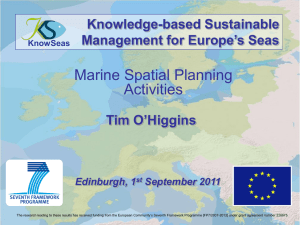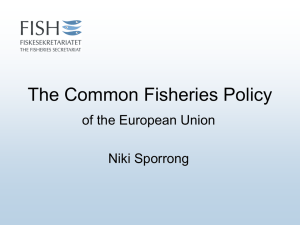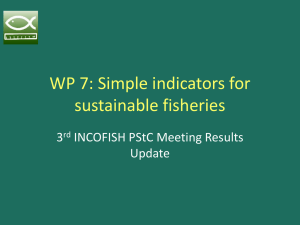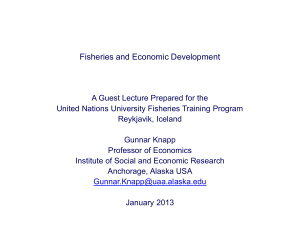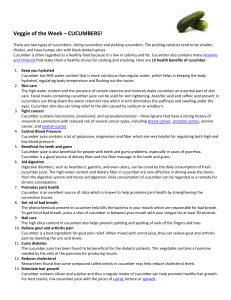Global analysis of sea cucumber fisheries
advertisement
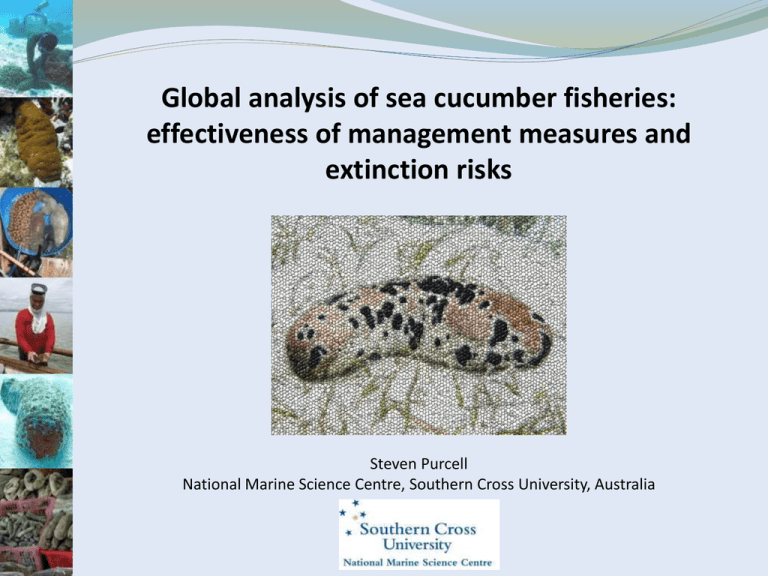
Global analysis of sea cucumber fisheries: effectiveness of management measures and extinction risks Steven Purcell National Marine Science Centre, Southern Cross University, Australia Presentation overview Sea cucumber fisheries Results of global review of stock status and management In the journal: Fish and Fisheries 14: 34–59 Implications for fisheries management and conservation Extinction risk in sea cucumber fisheries Potential measures to mitigate extinction Are sea cucumber fisheries significant? Fished from Mediterranean and East Africa through Indo-Pacific to Central America Insatiable market demand from China Often the most valuable invertebrate fishery export from countries Recently more valuable than all fish exports in New Caledonia and Tonga Our data indicated probably >3 million people fishing sea cucumbers globally Status of Pacific sea cucumber stocks? Global sea cucumber production (t dried) Sea cucumber fisheries 20000 Aquaculture production Capture fisheries 15000 10000 Captures of high-value species 5000 0 1950 1960 1970 1980 Year 1990 2000 Scale of fishing Most Indo-Pacific fisheries are small scale Few fisheries were for subsistence only Number of species harvested 1 to 47 species exploited in each fishery Temperate species often mono-specific No. Species Harvested =1 = 10 = 20 = 30 Yields per fisher vs participation rate Landings per fisher in tropical fisheries (2004-2008) related significantly to participation rates. 2 – 10 fishers 100-km-2 Number of regulatory measures used & Enforcement capacity No. of 0 1 2 3 4 5 6 7 8 9 Key management measures used Significant difference in management measures used: Under-exploited Moderatly-exploited Fully exploited vs. 2D Stress: 0.15 Over-exploited Depleted Multivariate analysis Management measure % dissimilarity contribution Enforcement 9.7 Capacity control 8.9 Limited entry requirements 8.7 Rotational harvest closures 8.3 Number of species harvested 7.9 Status Rotatl. harv. Under expl. Mod. expl. Fully expl. Over expl. Depleted Gear restr. Enforc. Cap. control Quotas Limt. entry Licensing Size limits Seas. cls. No. reg. meas. Moratorium No. Species Reserves Key analysis conclusions Sea cucumber fisheries fare worse than most fisheries globally. Sustainability of troubled sea cucumber fisheries will only come from the adoption of radically different approaches to management Key changes needed for fisheries management Enforcement capacity is paramount to fisheries sustainability A set of at least 4 or 5 key regulatory measures is needed (but keep it simple!) The most successful regulatory measures: limited entry rules, fleet capacity regulations, restrictions on the number of harvested species, and licensing requirements. Allowing all species to be harvested opens the door to ‘opportunistic exploitation’ Measures to mitigate the loss of biodiversity Key points: no correspondence between the presence of marine reserves and the sustainability of fisheries marine reserves representing just a small proportion of habitats will not suffice as a sole management measure in sea cucumber fisheries International agreements and instruments may help safeguard loss of biodiversity in over-exploited or severely depleted fisheries (e.g., CITES listing and IUCN Red List) IUCN Red List of Threatened Species - assessment workshop on sea cucumbers, Colombia 2010 Evaluated extinction risk against IUCN criteria for 377 sea cucumber species (order Aspidochirotida) Relied on reports, research articles and country stock assessments to determine stock declines and distributions Extinction risk categories – IUCN Findings from Assessment workshop 7 species were Endangered 9 species were Vulnerable A high proportion (68%) of species were classed as Data Deficient High-value species tended to be most at risk of extinction Findings from Assessment workshop Low-income countries in the tropics have the highest number of threatened sea cucumber species Key management implications of IUCN assessment International market demand is a key driver of extinction in some invertebrate fisheries, like sea cucumbers Fishery managers should pay special attention to managing high-value species conservatively: Species-specific catch quotas, or Species-specific bans, or Exclude them from lists of allowable species CITES may help control trade, but CITES listing of sea cucumbers has so far proven difficult What would listing of certain species on CITES Appendix II or III mean? Appendix III Provides assistance to countries in the enforcement of national trade regulations. • Export permit required. • Only animals obtained in compliance with national laws (of the source country) can be traded. Appendix II Same as Appendix II plus the following: • Export permits should be granted only when “a Scientific Authority of the State of export has advised that such export will not be detrimental to the survival of that species”. In other words, countries must demonstrate that the trade is non-detrimental to the survival of the species in the wild. New Identification guidebook on sea cucumbers Intended for: Customs officers – dried product Fishery officers – live animals

